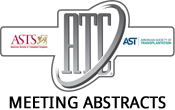2017 American Transplant Congress
BK Virus, Cytomegalovirus and Epstein-Barr Virus Reactivation in Renal Transplant Patients: Results from a Large Multicenter Study.
The purpose of this study was to ascertain the prevalence and clinical implications of three of the most relevant opportunistic infections in kidney transplantation, namely…2017 American Transplant Congress
De Novo, Non-Donor Specific HLA Antibodies Are Associated with Inferior Allograft Outcomes After Kidney and Simultaneous Kidney-Pancreas Transplantation.
Introduction: Donor specific antibodies [DSAs] occurring after transplantation are associated with poorer outcomes. However the significance of non-donor directed HLA antibodies [ndHLAs] after transplantation in…2017 American Transplant Congress
Is Peri-Transplant Plasmapheresis Effective in the Prevention of Recurrence of FSGS?
University of Minnesota, Minneapolis
Many pediatric centers utilize a variety of protocols including scheduled plasmapheresis to prevent the dreaded recurrence of focal segmental glomerulosclerosis (FSGS) post-transplant. But the effectiveness…2017 American Transplant Congress
Impact of Peri-Transplant Viral Upper Respiratory Infection on Pediatric Liver Transplant Outcomes.
BACKGROUND: Viral upper respiratory infection (vURI) is common in children and its effect at the time of liver transplant (LT) on the post-operative outcomes is…2017 American Transplant Congress
Clinical Significance of Alloantibodies in Hand Transplantation: Impact on Rejection and Functional Outcome.
Purpose: Although alloantibodies, and donor-specific antibodies (DSA) in particular, are well-known to negatively impact graft survival in human solid organ transplantation, little is known about…2017 American Transplant Congress
Circulating Inflammatory Factors in Deceased Organ Donors Result in Innate Immune Activation.
Surgery, Duke University, Durham, NC
Background: Superior outcomes of living-donor compared to deceased-donor transplants may be related to increased graft immunogenicity at the time of transplant. Donor brain death results…2017 American Transplant Congress
Outcomes Following Colectomy in Kidney Transplant Recipients.
Kidney transplant recipients (KTR), like the general population, often require surgical procedures for non-transplant related issues. Given the need for lifelong immunosuppression and the physiologic…2017 American Transplant Congress
Increased Use of Donation After Cardiac Death Donors Increases Access to Transplantation without Adverse Effect on Outcomes.
UT/Methodist University Hospital, Memphis, TN
IntroductionAs the transplant community discusses redistricting to address potential imbalance in loco-regional liver distribution, liver transplant programs will need to identify strategies to maximize access…2017 American Transplant Congress
Deceased Donors with a History of IV Drug Use and Donor Derived Hepatitis C Virus.
1OPTN Ad Hoc Disease Transmission Advisory Committee, Richmond, VA; 2UNOS, Richmond
Introduction:In 2015, the CDC reported a 172% increase in heroin-related deaths from 2010 to 2013. Deceased donors with IV drug use (IVDU) are at increased…2017 American Transplant Congress
Anti-Angiotensin Type 1 Receptor Antibodies Associate with Rejection in Simultaneous Pancreas and Kidney Transplant and Pancreas Transplant Alone Recipients.
Comprehensive Transplant Center, Cedars Sinai Medical Center, Los Angeles, CA
Background: Anti-angiotensin type 1 receptor antibodies (AT1R Ab) have been found to have a strong association with antibody mediated rejection (Reinsmoen et al, Transpl 2010;…
- « Previous Page
- 1
- …
- 36
- 37
- 38
- 39
- 40
- …
- 181
- Next Page »
